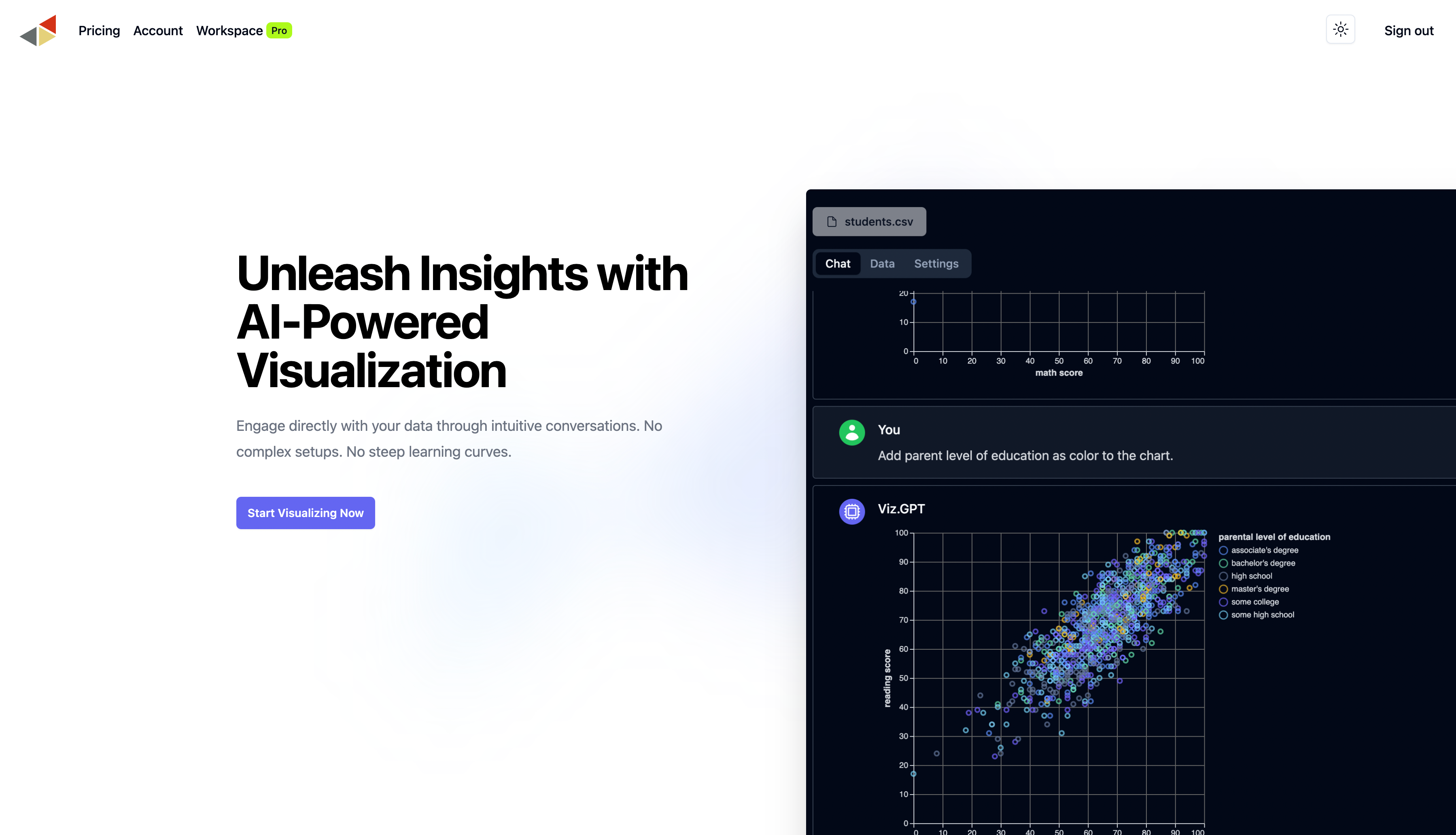Introduction
In the dynamic world of data visualization, the emergence of VizGPT.ai marks a significant leap forward. Designed to simplify and enhance the process of exploring complex datasets, VizGPT.ai stands out as a next-generation alternative to established tools like Tableau. This article delves into the unique features of VizGPT.ai, highlighting how it facilitates a more interactive and intuitive approach to data analysis.
Understanding VizGPT.ai
What Sets VizGPT.ai Apart?
VizGPT.ai is not just another text-to-chart product; it's a game-changer in the realm of data visualization. Its core strength lies in its advanced chat-based interface, which allows users to interact with their data conversationally. Unlike traditional tools where a complex query must be formulated upfront, VizGPT.ai supports an incremental, question-by-question approach, making it easier to refine and adjust visualizations on the fly.
Contextual Understanding and Deep Exploration
One of the most striking features of VizGPT.ai is its ability to understand and maintain context throughout a conversation. This means users can build upon previous queries, diving deeper into their data without repeating or rephrasing earlier questions. Such contextual awareness is crucial for exploring multifaceted datasets and uncovering hidden insights.
Comparing VizGPT.ai with Tableau
User Interface and Experience
While Tableau is renowned for its robust analytics capabilities and wide range of visualization options, VizGPT.ai introduces a more conversational and user-friendly approach. This can be particularly beneficial for users who may not have extensive experience in data analysis or familiarity with complex query languages.
Flexibility in Data Exploration
Tableau requires a certain level of planning and understanding of the data before analysis. In contrast, VizGPT.ai allows users to start with broader queries and narrow down their focus gradually, providing a more flexible and exploratory experience.
Practical Applications of VizGPT.ai
Scenario: Market Analysis
Imagine a marketing analyst looking to understand customer behavior trends over the last quarter. With VizGPT.ai, they could start by asking, "Show me the customer engagement trends last quarter." Based on the initial visualization, they could then follow up with, "Compare this to the same period last year," or, "Highlight the age groups with the most significant changes." This step-by-step exploration makes VizGPT.ai particularly adept at handling complex, evolving analytical scenarios.
VizGPT.ai vs. Hex.tech
Enhanced Data Exploration
Hex.tech, known for its analytics SQL notebook, offers a structured approach to data analysis. However, VizGPT.ai takes this a step further by providing a more natural and fluid data exploration workflow. With VizGPT.ai, users engage in a conversational manner, allowing for a more intuitive exploration of data without the need for complex SQL queries.
VizGPT.ai vs. Excel's Copilot
Superior Interactive Visualization
Excel's Copilot, while useful for integrating AI into spreadsheet tasks, primarily focuses on data manipulation and basic visual representation. VizGPT.ai, in contrast, excels in creating more sophisticated, interactive visualizations. This capability not only enhances user engagement but also provides deeper insights through dynamic data interaction.
VizGPT.ai vs. Code Interpreters
Advanced RAG Techniques and Interactive Output
Code interpreters are effective in translating natural language to code, but often produce static visual outputs. VizGPT.ai leverages more advanced Retrieval-Augmented Generation (RAG) techniques, allowing it to build more comprehensive analyses. Additionally, unlike standard code interpreters, VizGPT.ai generates interactive visualizations, offering a more engaging and informative user experience.
VizGPT.ai vs. Kanaries RATH (opens in a new tab)
Focus on Conversational Interface
Kanaries RATH (opens in a new tab) specializes in automating data science workflows, which is instrumental in streamlining data processes. VizGPT.ai, however, emphasizes its natural language chat interface, prioritizing ease of use and accessibility for a broader range of users. This focus makes VizGPT.ai particularly suited for those who prefer a more conversational and less technical approach to data analysis.
Q&A Section
Q: How does VizGPT.ai handle large datasets compared to Tableau?
A: VizGPT.ai is designed to efficiently process large datasets, offering quick response times and maintaining context even in extensive data explorations, comparable to Tableau's capabilities.
Q: Is VizGPT.ai suitable for users without a technical background?
A: Absolutely. One of VizGPT.ai's main advantages is its intuitive chat-based interface, making it accessible to users with varying levels of technical expertise.
Conclusion
VizGPT.ai represents a significant advancement in the field of data visualization. Its unique chat-based interface, coupled with its context-aware capabilities, sets it apart from traditional tools like Tableau. By enabling a more intuitive and flexible approach to data exploration, VizGPT.ai opens up new possibilities for users across various industries and expertise levels.
